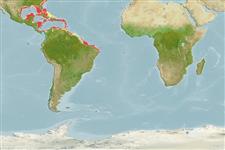Common names from other countries
>
Eupercaria/misc (Various families in series Eupercaria) >
Malacanthidae (Tilefishes)
Etymology: Malacanthus: Greek, mala = a lot + Greek, akantha = thorn (Ref. 45335).
More on author: Bloch.
Environment: milieu / climate zone / depth range / distribution range
Écologie
marin récifal; profondeur 10 - 153 m (Ref. 9626), usually 10 - 50 m (Ref. 9626). Subtropical; 34°N - 8°S
Western Atlantic: North Carolina (USA), Gulf of Mexico, and throughout the Caribbean to Rio de la Plata, Uruguay. Southeast Atlantic: Ascension Island.
Taille / Poids / Âge
Maturity: Lm ? range ? - ? cm
Max length : 70.0 cm SL mâle / non sexé; (Ref. 8991); common length : 50.0 cm TL mâle / non sexé; (Ref. 3644); poids max. publié: 1.0 kg (Ref. 40637)
Description synthétique
Clés d'identification | Morphologie | Morphométrie
Épines dorsales (Total) : 4 - 5; Rayons mous dorsaux (Total) : 53 - 57; Épines anales: 1; Rayons mous anaux: 50 - 52. Caudal fin lunate.
Primarily a shallow-water benthic species found on sand and rubble bottoms (Ref. 5246). Builds mounds of rubble and shell fragments near reefs and grass beds; enters its mound head first when frightened (Ref. 5246). Feeds mainly on stomatopods, fishes, polychaete worms, chitons, sea urchins, sea stars, amphipods and shrimps (Ref. 3644). Tends to bite when handled (Ref. 5246). Marketed fresh (Ref. 5246). Between 1995 and 2000, at least 7 specimens have been traded as aquarium fish at Ceará, Brazil (Ref. 49392).
Life cycle and mating behavior
Maturities | Reproduction | Spawnings | Egg(s) | Fecundities | Larves
Dooley, J.K., 1978. Systematics and biology of the tilefishes (Perciformes: Branchiostegidae and Malacanthidae) with descriptions of two new species. NOAA Tech. Rep. NMFS Circ. No. 411:1-78. (Ref. 8991)
Statut dans la liste rouge de l'IUCN (Ref. 130435)
CITES (Ref. 128078)
Not Evaluated
Menace pour l'homme
Traumatogenic (Ref. 5246)
Utilisations par l'homme
Pêcheries: intérêt commercial mineur
Outils
Articles particuliers
Télécharger en XML
Sources Internet
Estimates based on models
Preferred temperature (Ref.
115969): 23.6 - 28, mean 26.7 (based on 308 cells).
Phylogenetic diversity index (Ref.
82804): PD
50 = 0.6250 [Uniqueness, from 0.5 = low to 2.0 = high].
Bayesian length-weight: a=0.00537 (0.00236 - 0.01221), b=3.03 (2.82 - 3.24), in cm Total Length, based on LWR estimates for this (Sub)family-body shape (Ref.
93245).
Niveau trophique (Ref.
69278): 3.7 ±0.3 se; based on diet studies.
Fishing Vulnerability (Ref.
59153): Moderate to high vulnerability (54 of 100).
